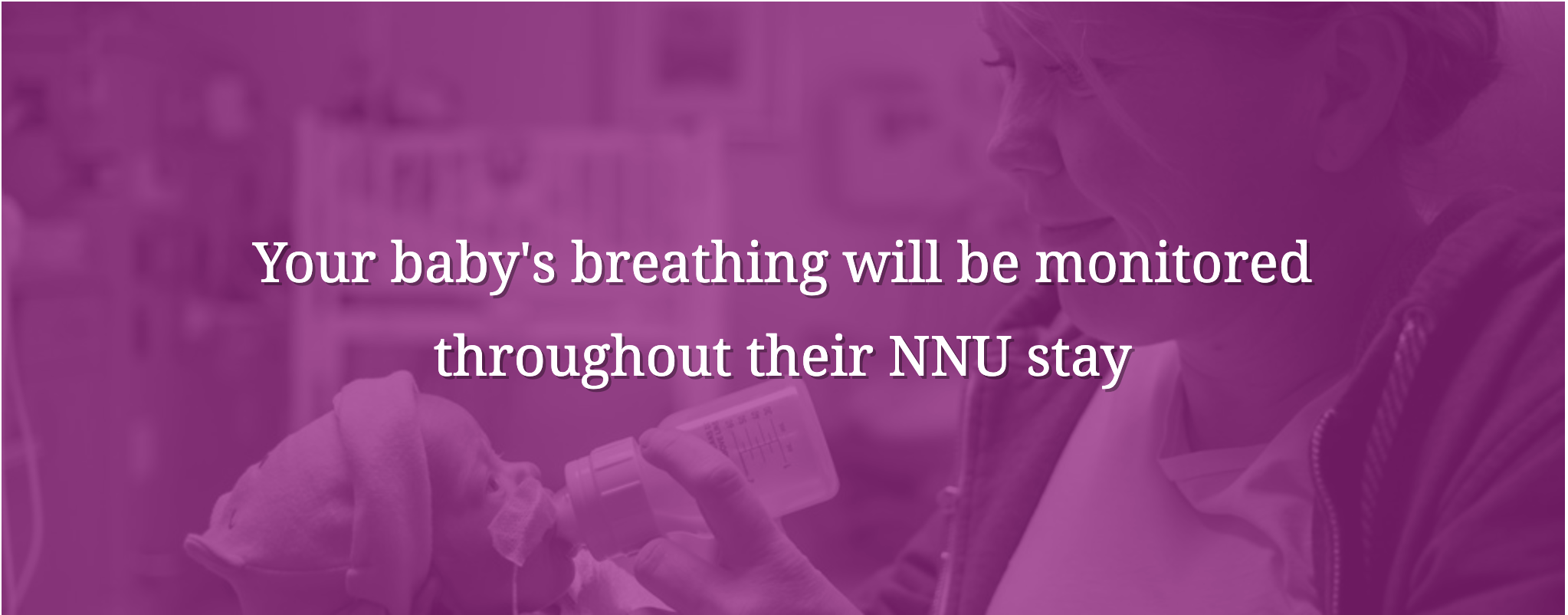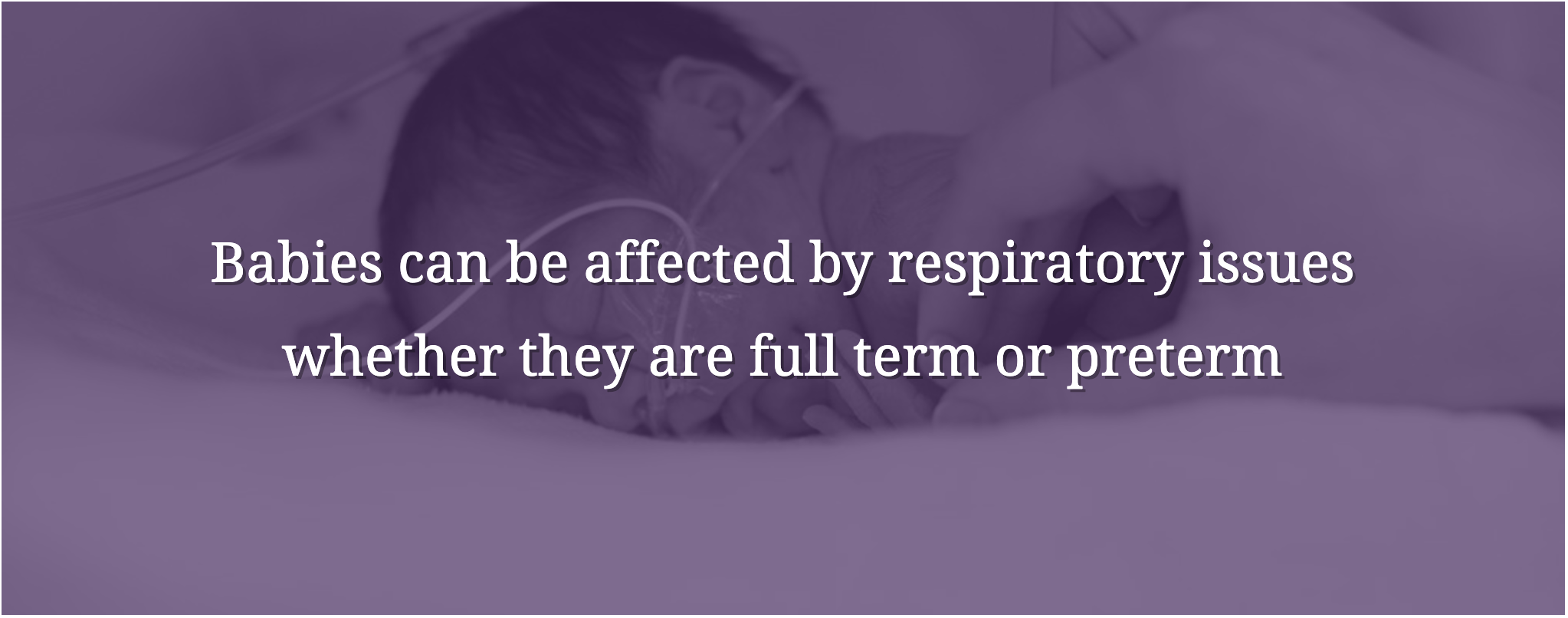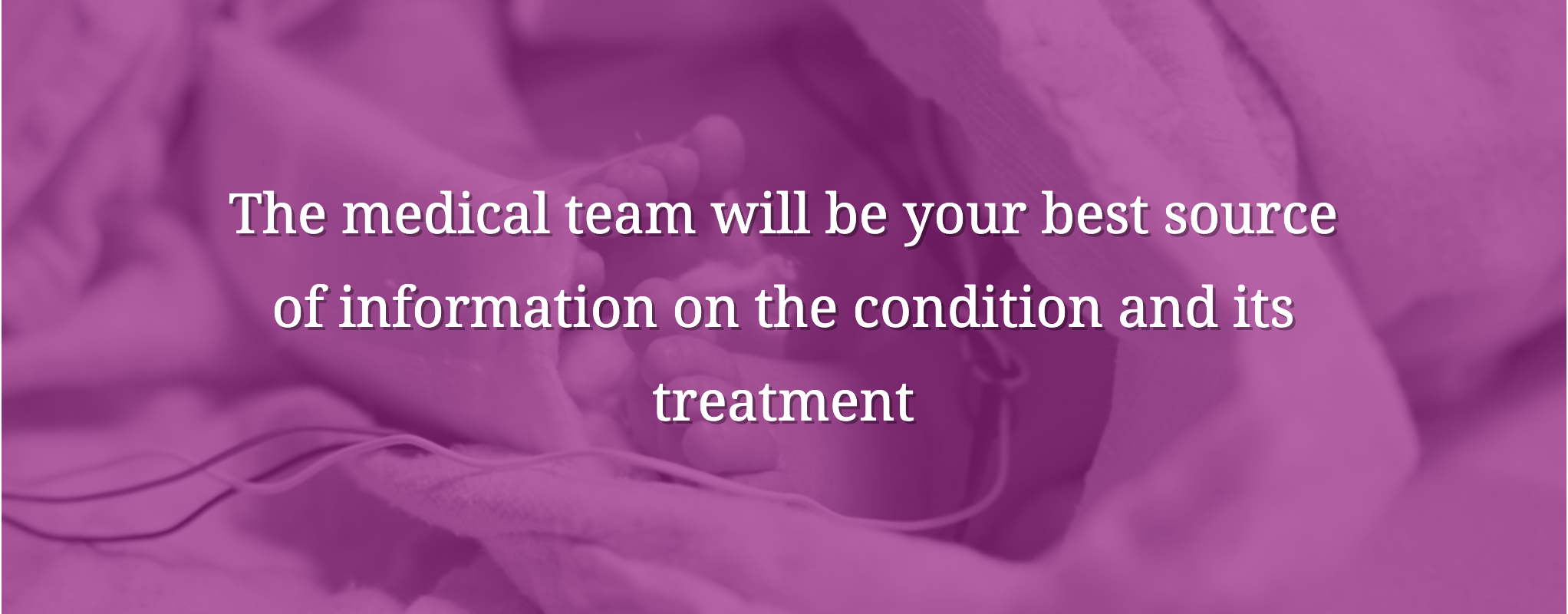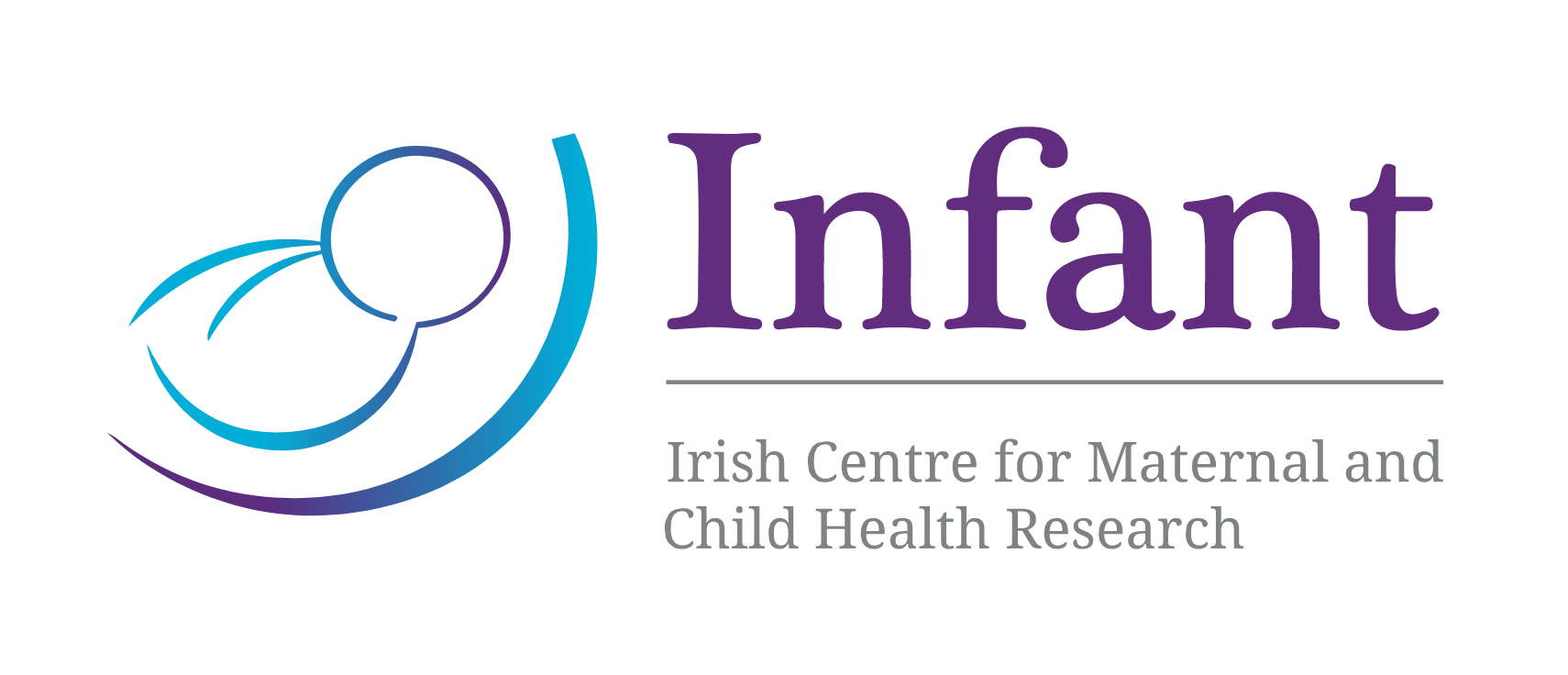Respiratory Conditions
Below, we will list common respiratory conditions and the treatments associated
Respiratory Distress Syndrome
Neonatal respiratory distress syndrome (RDS) is the number one reason for admission to the neonatal unit (NNU). The condition makes it hard for your baby to breathe due to a lack of a naturally-occurring, slippery substance in the lungs called ‘surfactant’. This substance helps the lungs fill with air and keeps the air sacs (or alveoli) from collapsing.
Most cases of RDS occur in babies born before 37 weeks’ gestation. In general, the more premature the baby, the higher the chance of RDS after birth. Babies born before 34 weeks’ gestation, or who have a low birth weight, e.g., below 2 kg, are at risk of a reduced amount of surfactant production and underdeveloped lung tissue. These babies may have difficulty in breathing which may cause:
- Nostrils that open wide or flare when the baby takes a breath.
- Skin and muscles that look like they are caving in between the baby’s ribs or under the baby’s ribcage.
- Grunting when the baby breathes out.
If your baby has RDS, they may be ‘intubated’. This means passing an endotracheal tube down their trachea (or wind pipe) towards their lungs. The doctor may use this tube to pass surfactant directly into your baby’s lungs. This will make the lungs more flexible and make breathing easier for your baby. While your baby is intubated, they may have an umbilical arterial catheter (UAC) or umbilical venous catheter (UVC) in place. These are tiny tubes that are placed in an artery or vein of the umbilical cord that provide quick access to your baby’s circulation. Babies that have difficulty breathing will be given extra support to breathe, e.g., through mechanical ventilation, continuous positive airway pressure (CAPA) support, or given an oxygen rich environment.
Although most babies recover from RDS, some babies do experience some long-term problems if the RDS is severe. These include:
- Increased severity of colds or other respiratory infections especially in their first two years.
- Increased sensitivity to irritants, such as cigarette smoke, pollution, etc.
- Greater likelihood of wheezing or other asthma-like problems in childhood compared to babies without RDS.
- Greater likelihood of hospitalisation in their first two years.
- If the RDS is very severe, they may have injury and scarring of the lungs known as Broncho-Pulmonary Dysplasia.

Bronchopulmonary Dysplasia
Babies aren’t born with bronchopulmonary dysplasia (BPD), formerly known as chronic lung disease (CLD). This condition develops when premature, low birth weight babies with respiratory distress syndrome (RDS) need help to breathe for an extended period of time. This can lead to inflamation or swelling and carring in the lungs which cause the lungs to become more stiff. This stiffness will force your baby to work harder at breathing. This may cause your baby to get tired easily during feeds and establishing oral feeds may be slower.
Although most babies fully recover, with few long-term health problems, BPD can be serious and may require intensive medical care. It may be necessary to discharge some babies with BPD home on oxygen. If your baby requires oxygen at home, the medical team will ensure that your home has been set up for oxygen treatment and will give you portable oxygen devices for when you are out of the home with your baby. Whilst this can be frightening for many parents, rest assured that it won’t take long to adapt.
Your baby will be monitored closely by their doctor/neonatologist, and gradually weaned off oxygen over time.
Transient Tachypnoea of the Newborn
Transient Tachypnoea of the Newborn (TTN) is the term used to describe a baby’s rapid breathing (more than 60 times per minute). This condition is more common in term newborn babies than preterm babies.
Babies lungs do not function the same way in the womb (‘in utero’) as they do outside of the womb. In the womb, a baby’s lungs are filled with amniotic fluid. This fluid begins to be absorbed out of the lungs and into the bloodstream as the baby gets close to term. In addition, the onset of labour and delivery leads to further absorption. The fluid normally is gone by the time the baby is born. For some babies, the fluid does not go away as quickly as it should and it is not fully absorbed by the time of birth.
A small amount of fluid can remain in the tissue and may cause temporary difficulties. This may be referred to as ‘wet lung’ and is a major cause of TTN. This is even more relevant to babies born by elective (planned) caesarean section and babies of diabetic mothers.
Symptoms of TTN usually happen within 2 hours after birth. They include:
- Fast breathing: more than 60 breaths per minute.
- Skin that looks blue or dusky
- Difficulty in breathing
Symptoms of TTN usually last between 12-72 hours and it can be diagnosed through an X-ray. TTN usually goes away by the time the baby is 3 days old. Until then, treatment for TTN may involve the following: observation; an oxygen rich environment, e.g., within an incubator or using nasal prongs; and/or mechanical respiratory support. If TTN persists, your baby may be fed via a nasogastric/orogastric tube to allow them to rest. Whilst waiting to confirm the diagnosis of TTN, there may be a brief period when your baby is given intravenous antibiotics.

Meconium Aspiration Syndrome
Meconium is a thick, black/green and odourless material first seen in the fetal intestine during the third month of pregnancy. This meconium is normally passed from the intestine within the first 24-48 hours after birth. The stress your baby experiences before, or during, birth may cause them to pass meconium stool while still in the uterus (womb).
This causes your baby to inhale a mix of amniotic fluid and meconium. This event is known as Meconium Aspiration Syndrome (MAS). It is defined as respiratory distress in a baby born through meconium-stained amniotic fluid. MAS is evident by a dark staining of normally clear amniotic fluid once the membranes rupture, when the ‘waters break’.
Generally, MAS is not life-threatening, but it can cause significant health complications for a newborn baby. Respiratory distress is the most noticeable symptom of MAS. Meconium is highly irritant, and when inhaled causes lung inflammation. Your baby may find it difficult to breathe, will breathe rapidly, and/or grunt during breathing. Therefore, your baby may require mechanical ventilation to help them breathe.
In very severe cases, MAS can cause prolonged health difficulties and can present complications such as respiratory failure, pulmonary air leaks, and persistent pulmonary hypertension. Some newborn babies may stop breathing if their airways are blocked by meconium. These babies may also exhibit the following symptoms:
- a slightly blue skin colour, which is called cyanosis
- limpness
- low blood pressure
If MAS occurs, your newborn baby will need immediate treatment to remove the meconium from the upper airways. After delivery, the doctor will immediately suction the nose, mouth, and throat. Then, a tube will be placed into your baby’s windpipe (or trachea) to suction the fluid containing meconium from their windpipe. The suctioning will continue until no meconium is seen in the material removed.
If your newborn infant is not breathing or has a low heart rate, your doctor will use a bag and mask to help them breathe. This will deliver oxygen to your baby and help inflate their lungs. After emergency treatment has been provided, your baby will require antibiotics, as meconium in the lungs can cause infection.
They will also be nursed in an incubator because they’ll need continuous monitoring and/or an increased oxygen supply. In some cases, a tube may be placed into your baby’s windpipe to help them breathe if they are very ill or not breathing on their own.
Pneumonia
Pneumonia is the condition where the lungs are inflamed. It is usually caused by an infection from group B streptococcal bacteria but can be caused by a virus. If the onset of pneumonia occurs within hours of birth, your baby may have acquired it before, or during, birth, and it is likely part of a generalised sepsis syndrome. However, i the onset of pneumonia is after 7 days, the infection will be likely confined to the lungs. The risk of a baby developing pneumonia is increased in cases where the mother has:
- an unexpected high temperature in labour
- prolonged rupture of membranes
- a meconium-stained or foul smelling liquor/amniotic fluid
- a history of recurrent genitourinary infection in pregnancy
However, in the neonatal unit (NNU) it commonly occurs among babies who require prolonged endotracheal intubation because of lung disease.
Pneumonia can be difficult to diagnose in newborn babies because it can be difficult to obtain secretions from them. Signs may be limited to respiratory distress, but may also include the following:
- a high temperature, typically over 102 °F
- fatigue
- sleepiness
- weakness
- lack of energy
- and/or laboured breathing
Breathing patterns may be either rapid, but shallow, or from the stomach instead of the chest. These breathing patterns may also be along with excessive nose flaring or wheezing. There is also the possibility that your baby will need some help breathing through mechanical ventilation. If your baby is too breathless or is breathing too fast to feed from the breast or bottle, they may require some tube feeds until they are well again.
Diagnosis is made by X-ray, as well as a clinical and laboratory evaluation (observation and blood tests) if testing for a generalised sepsis syndrome. Treatment is initially with broad-spectrum antibiotics which are changed to organism-specific antibiotics as soon as possible following laboratory results/culture reports. To fight the infection, antibiotics are given through an intravenous line, also known as a ‘drip’, or cannula.

Pneumothorax
Your baby’s lungs contain thousands of air sacs called alveoli. These air sacs allow the lungs and blood to exchange oxygen and carbon dioxide. Sometimes, the air in these air sacs leaks out and into the space surrounding the lungs. This causes a ‘pneumothorax’ which prevents the lungs from fully expanding and can lead to rapid breathing (tachypnoea).
Sometimes, term newborn babies develop spontaneous pneumothorax after birth with no identifiable cause. These babies are allowed to rest and are given fluids through a tube or intravenous line as well as extra oxygen. In general, the pneumothorax is small and resolves over time. If the pneumothorax is large and severe, it may be necessary to pass a small tube through the chest wall. This is referred to as a chest drain. A chest drain helps the air leave the surrounding tissue; allowing the lung tissue can expand again. The diagnosis and monitoring of the pneumothorax are generally through clinical examination and intermittent chest X-ray.
Structural Abnormalities
Some babies may have structural abnormalities of their airways which may cause blockage or difficulty breathing. These abnormalities include:
- Choanal atresia or bronchomalacia.
- Developmental abnormalities, e.g., congenital diaphragmatic hernia and tracheoesophageal fistula.
- Mechanical abnormalities, such as rib cage anomalies, pleural effusion, spinal muscular atrophy, etc.
Apnoea and Bradycardia
Apnoea is a period when your baby forgets to breathe. This is very common in premature babies, especially when sleeping. Your baby may take too long a pause between breaths, or occasionally their breathing stops. Apnoea of prematurity is the most common cause of apnoea. This is because a preterm baby has an immature respiratory centre in their brain and an under-developed nervous system.
Your baby’s apnoea can also be caused, or aggravated, by many other problems, such as infection, low blood sugar, patent ductus arteriosus, seizures, high or low body temperature, brain injury, or insufficient oxygen. Apnoea occurs in 50% of babies with a birth weight less than 1500 grams and in 90% of babies with a birth weight less than 1000g [2].
A pause in breathing (apnoea) has one, or more, of the following characteristics:
- lasts more than 15 seconds
- is associated with the baby’s colour changing pale, purple, or blue
- and is associated with bradycardia (slowing of the heart rate)
If your baby is on a ventilator, it doesn’t matter if they take a pause in their breathing as the ventilator is assisting them or is doing all the work for them. Once your baby is taken off the ventilator, any pauses are a cause for concern.
However, all babies in the NNU have continuous cardiac and saturation (oxygen levels) monitoring. Respiratory and heart rates are detected using probes attached to your baby. If the probe and monitor register a value outside the ideal ranges set for your baby, an alarm will sound.
Note: sometimes the alarm will sound due to poor contact with the skin or the probe falling off, please speak to your medical team when it happens.
Treatment for Apnoea:
- When the alarm sounds, their nurse will respond and observe your baby. The nurse will gently touch your baby’s body and/or quietly speak to your baby to stimulate them to breathe again. Your baby’s colour will be noted as well as their response to the stimulation. If your baby is slow to respond or apnoea events are new to your baby, they will be checked by their doctor.
- Sometimes a stimulant medication, such as caffeine, may be prescribed. Initially, a higher loading dose is given to stimulate breathing followed by once or twice daily administration for continuous stimulation. As with most medications, the dosing is based on the weight of your baby and may be adjusted as your baby increases in weight. When the medication is discontinued, caffeine levels in the baby’s body decreases over a few days; the impact of withdrawal is minimal.
- There are times when an apnoea event is due to your baby’s positioning, e.g., your baby’s neck may have fallen forward causing their airway to narrow or close. To prevent this, the medical team are very conscious of the way your baby is positioned. Placing your baby prone, i.e. on their tummy, and carrying out kangaroo care can reduce the number of apnoea events. Please note that allowing your baby to rest/sleep in the prone position is only appropriate when they are in the NNU as they are being continuously monitored. This position is not recommended when at home.
- Mechanical ventilation: Your baby may also need some respiratory support in the event of continuous or prolonged apnoea events. This may be given in the form of continuous positive airway pressure (CPAP). During CPAP, your baby may be breathing by themselves but is supplied with a little bit of pressure which gently forcing the air into their lungs. This assistance prevents the small air sacks in the lungs from emptying and collapsing completely. It also ensures your baby doesn’t tire too easily from breathing.
As your baby matures, apnoea of prematurity generally resolves and your baby’s medication, if any, is discontinued. In general, this happens at about 35 to 36 weeks’ gestation. If at any time a colour change is noted or your baby seems not like themselves, even if all monitors are showing normal vitals or values, your baby will be checked by their nurse and reviewed by a doctor, if necessary. If at any time you feel your baby is not handling well or as normal, please do not hesitate to speak to your nurse or doctor. They know that nobody knows your baby better than you and appreciate your input at all times.
References
[2]www.hse.ie/eng/about/Who/clinical/natclinprog/paediatricsandneonatology/resources/Apnoeaprematurity.pdf ( omit gestation / weeks)
